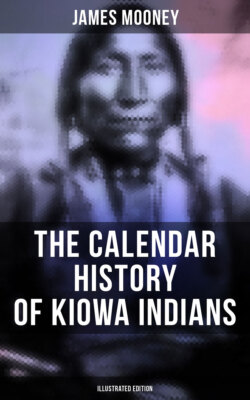Читать книгу The Calendar History of Kiowa Indians (Illustrated Edition) - James Mooney - Страница 54
На сайте Литреса книга снята с продажи.
Death of Dohásän
ОглавлениеTable of Contents
In the course of the talk Dohásän, on behalf of his people, made a vigorous protest against being confined to a reservation, claiming that the Kiowa owned from Fort Laramie and the North Platte to Texas and had always owned it, and that he did not want his country cut up and divided with other tribes or given to the white man; his people wanted a large country to roam over; they did not want to stay long in one place, but wanted to move about; the Santa Fé road was open and would not be disturbed, but the rest of their country he wanted let alone. Notwithstanding this protest the treaty was signed. Among others officially present were Kit Carson, William Bent, and Agent Leavenworth, with William Shirley and Jesse Chisholm as interpreters (Report, 17). Dohásän died shortly afterward, early in 1866, and with his death began the rapid decline of the Kiowa tribe. He was succeeded by Gúi-pä´go, "Lone-wolf," adopted father of the present chief of the same name. But the Indian day was drawing to a close. Within a few years the Kiowa were practically prisoners on a reservation, and their chiefs were the creatures of petty factions and mere figureheads in the hands of the government.
